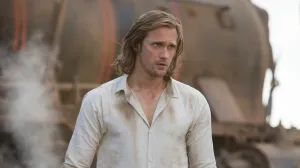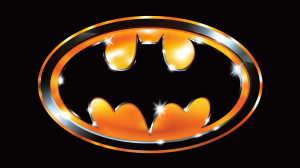When watching HBO’s Watchmen, it’s impossible to miss the nods, links, and themes that connect the Damon Lindelof “remix” series to the Alan Moore and Dave Gibbons comic book series. Those links are, generally, very deliberate in that they firmly establish the world of the television series as being part of the Watchmen world, just thirty years on. A name drop here, a squidfall there, all direct ties from one world to the other. But there are also links that are more subtle that tie the characters of the present to the comic book past, the best example of which is Looking Glass. The character is, in many ways, the television series’ take on a contemporary Rorschach — something the show itself nods to when in the series’ fifth episode the character eats from a cold can of beans something Rorschach did in the comics.
Videos by ComicBook.com
But while Looking Glass and Rorschach share similarities beyond the beans for dinner situation — Looking Glass/Wade Tillman (Tim Blake Nelson) is, like Rorschach, a loner whose masked identity is used to turn people’s emotions back to them — there are also significant differences in the two characters and they are differences that can perhaps be best examined by looking at the evolution of the character that inspired Rorschach, The Question.
For those who aren’t familiar, Moore originally wanted to use characters that DC Comics had acquired from Charlton Comics in 1983 for the comic book series that would become Watchmen but was ultimately told no and persuaded to create his own characters for the story. When it came to the creation of Walter Joseph Kovacs, aka Rorschach, Moore took cues in part from Steve Ditko’s The Question. The character has a strict if not skewed moral code who, as Slate’s Joe George puts it in his examination of the links between Rorschach and Looking Glass, “whenever news anchor Vic Sage uncovered a mystery, he punched his way to answers as the Question, content to let evildoers suffer horrible fates as the just reward for their poor decisions.” It’s brutal, but effective and disturbing as well.
In the comics, Rorschach is very much the same. Rorschach also has a strict and skewed moral code — specifically around sexual matters with Rorschach having a very externalized virgin/whore view of women — and also obscures his face as he seeks to fight crime in the framework of his own view of the world. He is, like The Question, brutal and uncompromising and it is something that ultimately leads to his death, though his journal lives on and helps to inspire the racist, violent Seventh Kalvary in HBO’s Watchmen. That group may be missing some of the spirit of Rorschach’s crusade, but they certainly have the strict adherence to their own moral code down cold as racist and violent as it may be.
Looking Glass, in contrast, doesn’t share the same brutality and strict moral code as Rorschach. Instead, Looking Glass seems to hew more the version of The Question from Dennis O’Neil and Denys Cowan’s take on the character from the 1987-1990 solo series. In that series The Question is nearly killed after being shot in the head and thrown into the river to drown, but he survives thanks to Lady Shiva and ends up encountering Richard Dragon, from whom he learns martial arts and eastern philosophy — something that shifts his worldview from the Randian objectivism that was such a core component of the character previously. It creates an ambiguity about the character who tries to balance the brutality of his crimefighting with his changing philosophical beliefs.
It’s that ambiguity of sorts that is perhaps what defines Looking Glass and sets him vastly apart from Rorschach despite their general similarities. While Watchmen portrays the character as something of an aloof loner early on, in “Little Fear of Lightning” viewers come to understand why that is with the tragic origin of the character. Young Wade survives the squid attack, having been lured into a fun house by a Knot Top girl who embarrasses him sexually by stealing his clothes and running away moments before the catastrophe. It’s that experience, being left naked and humiliated in the funhouse moments before the catastrophe, that signals that Wade will be different than Rorschach. Young Wade doesn’t blame the girl and her perceived sinfulness (which Rorschach would classify as “whore” behavior in his very black and white worldview) for his predicament. He turns his blame onto himself. It’s something that deeply cemented in the young man when the squid attack happens moments later, killing millions around him. Later, as Looking Glass, he will continue to internalize much of his trauma — something that Nelson himself has previously discussed. His personal relationships will suffer, but he retains a bit of forced optimism even as he lives in terror of another attack. That is most evident in how he leads a support group for those impacted by the Dimensional Incursion Event even though he himself is still broken. He also applies his moral code on the world around him not by trying to force it to conform to him but, instead, trying to make the world a better place in a sense within the framework of his job in law enforcement.
To put it simply, if Rorschach is The Question as Steve Ditko created him, Looking Glass is the evolved version O’Neill and Cowan expanded upon, a man who doesn’t really know where he places in the complex and terrifying world he lives in, one that he’s come to learn is built entirely on a lie. It’s an interesting take, but it also serves a larger purpose within the series as well as the narrative around the themes of Watchmen. By having Looking Glass share similarities with the more contemporary take on The Question, it creates an interesting space for HBO’s Watchmen to truly examine Rorschach and his long shadow not only over the world of Watchmen, but perhaps on popular culture on the whole especially in a time where objective truth may not exist.
Watchmen airs Sundays at 9/8c on HBO.








